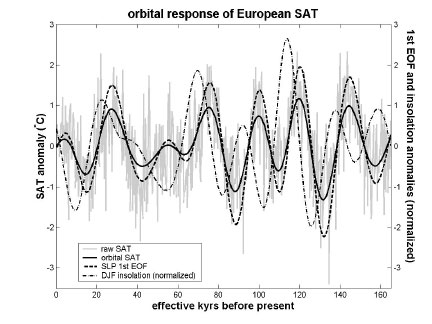
|
||||||||||||||||
|
|
Global climate research: Paleoclimate The importance of atmospheric dynamics in the northern hemisphere wintertime climate response to changes in the earth's orbit The famous Serbian mathematician Milutin Milankovitch proposed that variations in earth’s orbit are the main cause of the huge climate fluctuations of the past million years. According to Milankovitch, this took place through a local thermodynamic response to changes in solar radiation. We test this hypothesis by examining variability in an atmospheric general circulation model coupled to an ocean mixed layer model subjected to orbital forcing of the past 165,000 years. During northern hemisphere summer, the simulation's response conforms to Milankovitch’s hypothesis, with high (low) solar radiation generating warm (cold) temperatures throughout the hemisphere. However, during northern hemisphere winter, the climate variations stemming from orbital forcing cannot be solely understood as a local thermodynamic response to radiation anomalies. Instead orbital forcing perturbs the atmospheric circulation in a pattern bearing a striking resemblance to the northern annular mode, the primary mode of simulated and observed unforced atmospheric variability (also known as the North Atlantic Oscillation). The hypothesized reason for this similarity is that the circulation response to orbital forcing reflects the same dynamics generating unforced variability. These circulation anomalies are in turn responsible for significant fluctuations in other climate variables: Most of the simulated orbital signatures in wintertime surface air temperature over mid-latitude continents are directly traceable not to local radiative forcing, but to orbital excitation of the northern annular mode. For example, the figure above shows that the simulated time series of wintertime surface air temperature over Europe (solid curve) is perfectly correlated with the time series of the orbitally-forced variations in the northern annular mode (dashed curve), while it is completely uncorrelated with the time series of wintertime solar radiation anomalies due to orbital forcing (dashed-dotted curve). This is consistent with known effects of the northern annular mode on Europe's temperatures: When the northern annular mode index is high, warm ocean air moves over Europe. These results have paleoclimate implications: During the point of the model integration corresponding to the last interglacial (Eemian) period, approximately 130,000 years ago, the orbital excitation of the annular mode generates a 1-2°C warm surface air temperature anomaly over Europe, providing an explanation for the warm anomaly of comparable magnitude implied by the paleoclimate proxy record. Our results imply that interpretations of the paleoclimate record must account for changes in surface temperature resulting not only from a direct thermodynamic response to changes in solar radiation, but also by orbitally-driven perturbations in atmospheric dynamics. Download the publication (Hall et al. 2005) describing these results in more detail. |
||||||||||||||

